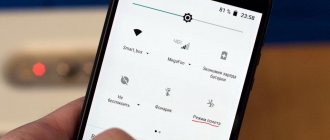How to enable do not disturb mode
On almost all modern smartphones, Do Not Disturb mode is activated in the same way. However, depending on the Android , the process may be slightly different. Instructions:
Step 1 . Press and hold the Volume Down button until the Do Not Disturb icon appears. Here you can call up an additional menu and adjust the volume of various alerts manually.
Step 2 . On some smartphones, you just need to press the “Volume Down” button once and then tap on the “Do Not Disturb” icon. To adjust the volume of different notifications, click on the three dots icon.
Step 3 . If using the physical buttons does not turn on Do Not Disturb mode, then you can do it differently. To do this, open the notification panel and tap on the “Mute” icon.
Once you turn on silent mode, your smartphone will no longer receive sound notifications. If necessary, you can set vibration for some notifications or incoming calls.
How to Block Incoming Calls on iPhone
The blacklist function was already present in the seventh version of iOS, and then was retained in later versions - the eighth, etc. Since then, any iPhone user can send an annoying caller to this list, and this procedure is done very easily. I must say, many Apple fans were happy about this function. But today it is successfully implemented not only in smartphones, but also in regular mobile phones. If you add a contact that is no longer needed to the black list, calls from him will no longer be received.
To blacklist a specific person from your contacts on your Apple smartphone, do the following:
- Go to the phone menu, then to recent tabs or to the contacts section.
- Click on the contact you are looking for to open information about it.
- Go down to the bottom of the window and activate the blocking function for this subscriber. The contact will be blacklisted and you will no longer receive calls from him.
If you subsequently want to unblock one or more subscribers who are on the black list, go to the settings menu of your smartphone, select the phone section and the blocked tab. Here you can unblock contacts by performing intuitive actions.
Through the help menu, the user can remove a contact from the list of blocked ones, as well as add new contacts to the black list directly from the address book.
In face time, blocked subscribers can be seen in the settings section of the same name.
How to set up do not disturb mode
For more comfortable work with silent mode, you can adjust the volume of different notifications (incoming calls, notifications, alarm clocks). Instructions:
Step 1 . Bring up the notification panel and turn on silent mode. After that, long press on the item “Mute” or “Do not disturb” (depending on the version of Android it may have a different name) to go to settings.
Step 2 . In the menu that opens, configure notifications, rules (schedule of days of the week) and other important parameters. For example, only allow incoming calls and messages from tagged contacts.
Step 3 . On some smartphones, you can manually adjust the volume of different notifications and other settings. For example, block incoming calls or limit pop-up notifications, set up a schedule to turn on automatically.
Depending on your Android , different options may be available in your notification settings. In addition, the same options may have different names.
How to configure this functionality
While the basics of Do Not Disturb are very simple, some of the advanced settings are not immediately clear. If the essence of the “Complete Silence” option is obvious, then “Priority Mode” will not be of any use until you enter the necessary parameters. How does DND work with these settings?
Basically, Android defines notifications in a few different ways: alarms, reminders, events, messages, and calls. If you go to Settings > Sounds > Do Not Disturb, you can toggle the Priority notification types. Message options offer even more granular controls, allowing you to set certain contacts as priorities. This means they can contact you even if Do Not Disturb is activated.
The regulation of calls in this mode is basically the same, with only one addition: skip repeat calls. This means that if the same person calls you twice within a 15-minute period, the call will be allowed through the DND setting.
What is this in practice? After configuring these settings, you can switch DND to "Total Silence" mode, in which no notifications will pass through "Priority Mode" other than those specified in the previous step.
How to disable do not disturb mode on Android
To turn off silent mode, simply press and hold the physical Volume Up button for a few seconds, or cancel it through the notification panel.
On some smartphones, you can also set a schedule to automatically turn silent mode on and off. How to do it:
Step 1 . Go to silent mode settings. To do this, press and hold the Do Not Disturb or Silent button. On the page that opens, go to the sound profile settings and select “Schedule.”
Step 2 . Add a new timer or edit an existing one. To do this, tap on it, and then configure the schedule and other parameters. After that, make sure that the slider is in the “Enable” position.
Step 3 . Some smartphones use the “Rules” option to set up a schedule, where you can set silent mode to automatically turn on and off on certain days of the week.
Once you set the schedule, silent mode will automatically turn on and off at night or on certain days of the week, according to the settings you select.
How to set an iPhone alarm?
- If you use the standard Clock application, you can go into it and click the Alarms tab at the bottom. All the settings you need will be here. Add a new time for which the device will operate and set a repeat if necessary. You can also set the desired sound, which will notify you when it is triggered. It is very important to note that once turned off, the phone will no longer sound to wake you up again in case you accidentally fall asleep. You can set the “Repeat signal” option so that the phone sounds again after 10 minutes.
- There are also alarm clock apps on iPhone that can easily cope with the task of waking you up. Some of them will ask you to solve a puzzle, and until you do, the phone won't stop screaming. You can find simply convenient applications that will have more detailed settings than in the standard case. For example, Waky, Budist, Smart Alarm.
We offer another article on the topic How to change the melody and sound (volume) of the iPhone alarm clock. Now you are in full control of the question.
Unlike older phones, the alarm on your iPhone won't work if your phone is turned off. But the ringtone will play if your iPhone is in silent or do not disturb mode.
Old Nokia and other phones had a great feature: the alarm would sound even when the phone was turned off. This meant you could go to bed knowing your phone wouldn't make a sound until it was time to get up. Some Android phones still have this feature. But this doesn't apply to your iPhone or iPad.
What is the Bedtime option for?
Starting with iOS 12 (installation instructions), a new option called “Bedtime” has appeared in the Do not disturb section. The point of the innovation is to turn off the notifications themselves, and not just the sound. In other words, the Bedtime option allows you to hide notifications of new messages from the lock screen until the morning (but you can still view them in the Notification Center if you wish).
This mode is described in more detail in this material.
Will the timer, reminder, notification work?
Timers, calendar appointments, and reminders work the same way as an alarm clock. If you set a timer and then turn off your iPhone, the timer won't go off. Instead, when you turn your phone back on, the timer will go off immediately—presumably to remind you that you missed it.
Reader rating of this article: (11)
Do Not Disturb mode is a convenient and useful feature that very few Android smartphone owners use. Its essence is to reduce the number of calls and notifications during non-working hours. Moreover, many smartphones have an LED indicator for missed notifications, and a brightly flashing light in the middle of the night is not the best way to have a good rest.
In this article we will talk about how to set up this mode and use it as efficiently as possible.
What is the difference between simple silent mode and do not disturb mode?
Despite the fact that in each of these modes any notification (be it a call or a new message) is not accompanied by a sound signal, these functions are very different from each other.
In Do Not Disturb mode, the smartphone is able to filter calls and notifications, informing you only about the most important ones (for example, if a certain subscriber tries to call several times in a row or a person close to you calls).
In addition, unlike silent mode, here you can enable the sound of multimedia applications (YouTube, music, games).
Last but not least, the difference between these modes is the ability to hide application notifications both in the notification shade and on application icons! That is, in Do Not Disturb mode, you can make sure that your smartphone does not let you know about new events in any way. And as soon as he exits this mode, all notification icons will immediately appear in the curtain.
Thus, Do Not Disturb mode is a feature that will make your phone less likely to distract you with unimportant and non-urgent notifications. Silent mode only turns off all sounds on the smartphone (which is also sometimes useful and even more appropriate).
Will the alarm work in Do Not Disturb mode?
By default, the alarm will work regardless of whether this mode is turned on or off. Also, most smartphones allow you to select the type of events and notifications that should be triggered even in Do Not Disturb mode.
For example, on Samsung smartphones you can add the following events to the exception:
How to enable Do Not Disturb mode?
Regardless of the phone brand, the easiest way to enable this mode is to use the corresponding icon in the notification shade:
The mode is disabled in exactly the same way (the first press activates the function, the second press deactivates it).
Why does Do Not Disturb mode periodically turn on on its own on my smartphone?
Since this function can be turned on according to a schedule depending on various conditions (day of the week, time of day, or even the occurrence of events from the calendar), the “problem” should be looked for in the Do Not Disturb mode settings.
Next, we will look in detail at how this function is configured on smartphones from different manufacturers, and if this mode periodically turns on on your smartphone, just check the parameters below.
How to set up Do Not Disturb mode on Samsung smartphones?
To do this, go to the Settings of your smartphone, select the Notifications menu, and then open Do Not Disturb:
If your smartphone does not have the latest version of the Samsung shell (One UI), then open Settings and search for the phrase do not disturb.
Alternatively, you can simply tap on the Do Not Disturb icon (in the notification shade) and hold your finger on it for a couple of seconds.
Scheduled activation
By selecting the Enable Schedule menu item, you can set the days and times when your smartphone should go into Do Not Disturb mode:
For example, you can set your smartphone not to disturb you on weekends from 8 pm to 10 am.
Unfortunately, the Samsung shell does not support multiple schedules (for example, one time for weekends and another for weekdays). Smartphones from other manufacturers (see below) have more flexible settings for the schedule for turning on this mode.
Allow exceptions
As mentioned earlier, the beauty of this feature is that you can fine-tune exactly how your smartphone should handle new events:
By opening the Allow Exceptions menu, you can set the following filtering options:
- Alarm clocks . If you enable this option, the alarm will sound even in Do Not Disturb mode.
- Multimedia. The sound in games, players (music and video) and other applications will not be muted in Do not disturb mode.
- Touch sounds . This setting is responsible for playing sound when you touch the screen. By default, this sound is turned off when you switch to Do Not Disturb mode.
- Calls from . Here you can specify who to receive calls from in Do Not Disturb mode. You can select all contacts or only Favorites. If you want to ignore only unknown numbers, then you should select the Contacts Only option here.
- Messages from . The setting is similar to the previous one, only regarding messages.
- Subscribers, rep. call . By activating this option, the smartphone will notify you of a call if the subscriber calls several times within 15 minutes (even if you have disabled notifications from unfamiliar numbers).
- The last two points add to the exclusion of notifications from the calendar and other applications.
How to set up Do Not Disturb mode on Xiaomi smartphones?
To configure this function in the MIUI shell (on Xioami smartphones), you need to go to Settings, select the Sound and vibration menu and open the Silent | Do not disturb, then set the Do not disturb mode:
Here you can see approximately the same options as on Samsung smartphones:
- Allow incoming calls . We indicate from whom to receive calls, even if Do Not Disturb mode is turned on (for example, you can also block only unknown numbers by selecting Contacts only).
- Notify about repeated calls . By activating this option, the smartphone will notify you of a call if the subscriber calls several times within 15 minutes (even if you have disabled notifications from unfamiliar numbers).
- Limiting pop-up notifications . By enabling the option, the smartphone will not display new notifications in pop-up windows (convenient, for example, when you read a book before bed and don’t want all sorts of notifications to interrupt you from reading).
- Turn-on schedule . Unlike Samsung smartphones, here you can configure the schedule for turning on the mode much more flexibly and conveniently. For example, you can set your smartphone to go into Do Not Disturb mode from 10 pm to 7 am on weekdays, and from 9 pm to 10 am on weekends. Supports multiple schedules running simultaneously.
How to set up Do Not Disturb mode on Huawei smartphones?
As in all previous cases, you can simply lower the curtain, click on the Do Not Disturb mode icon and hold your finger for a couple of seconds. Or you can open your smartphone Settings, select Sound, and then go directly to Do not disturb mode:
Here you can activate the Do Not Disturb mode not only according to a schedule (Time), but also at the moment of events from the calendar (Event). By selecting Do Not Disturb Mode in the Advanced settings section of the menu, you can add exceptions:
To add phone numbers or contact type to exceptions, you need to set the switch to By priority (see screenshot above). After this, the Priority Events menu will become active:
All priority event settings in this menu are standard for Android. If you have people you don't want to miss a call from, be sure to add them to your exclusion list.
By devoting just a few minutes to detailed settings of the Do Not Disturb mode, you will make your smartphone even more convenient and less intrusive!
Did you like the article? Share with others:
- 47
- 1
- 1
How would you rate this article?
Click on the star to rate it
There are comments at the bottom of the page...
Write your opinion there for all readers to see!
Thank you very much for your feedback!
Sources used:
- https://support.apple.com/ht204321
- https://ipadstory.ru/rezhim-ne-bespokoit-na-ipad-iphone-ili-ipod-touch.html
- https://support.apple.com/ht207512
- https://www.it-ep.ru/other/srabotaet-li-budilnik-esli-iphone-vyklyuchen-v-rezhime-bez-zvuka-ili-ne-bespokoit/
- https://deep-review.com/articles/how-to-set-and-use-do-not-disturb-mode-android/
SHARE Facebook
- tweet
Previous articleXiaomi presents the Mi Alarm Clock and a 10,000 mAh power bank
Next articleMicrocontroller and Bootloader. Description and principle of operation.









